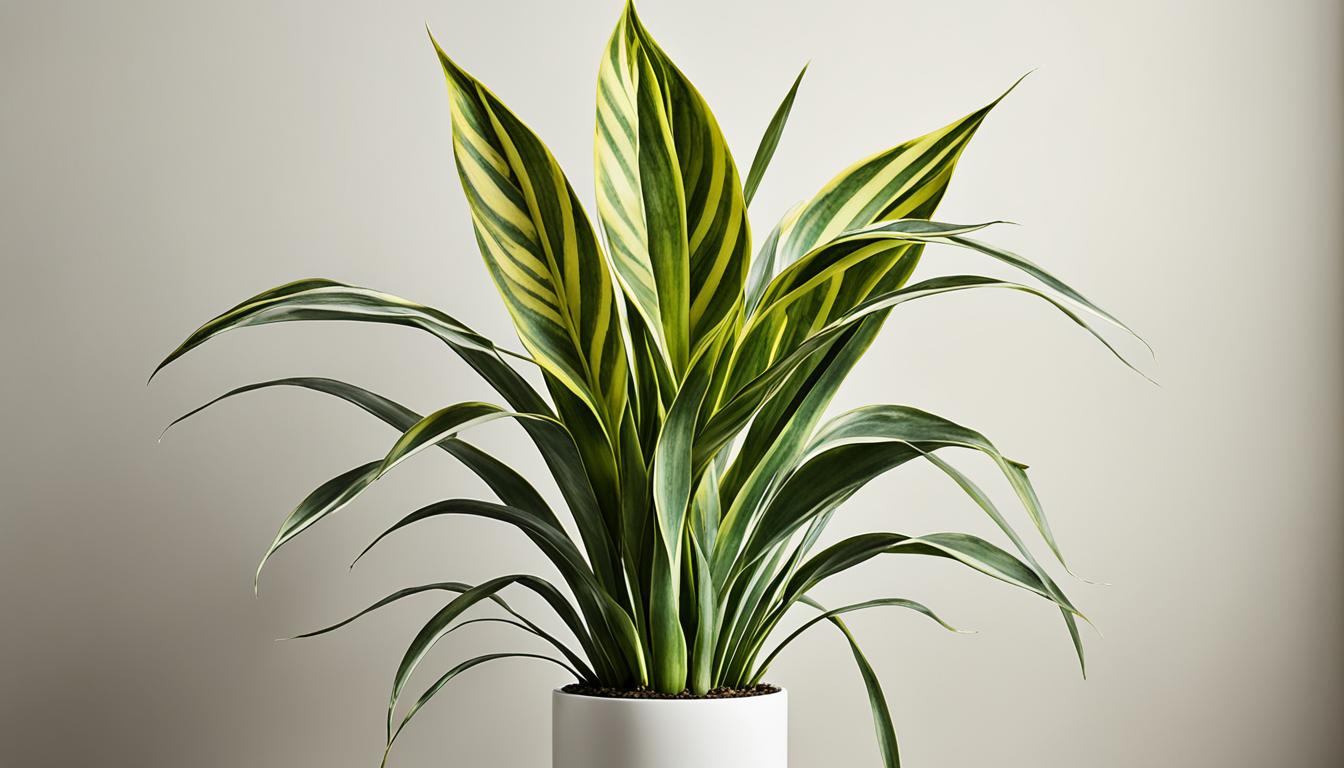Indoor plants make our air better, reduce stress, and help us work better. The Mikado Snake Plant is pretty and tough. It’s great for seasoned plant lovers and beginners. This guide will help you grow and care for a Mikado Snake Plant in your home.
Key Takeaways:
- Discover why the Mikado Snake Plant is an ideal choice for apartment living.
- Learn about its air-purifying properties and pet-friendly nature.
- Get insights into the optimal light, water, and nutrition requirements for the plant.
- Master the art of potting, propagation, and maintenance.
- Gain valuable tips for dealing with pests and diseases.
Why Do We Love the Mikado Snake Plant For Apartments?
The Mikado Snake Plant is great for apartments. It has benefits perfect for indoor living. This plant is loved by many who live in apartments.
Is the Mikado Snake Plant Air-Purifying?
The Mikado Snake Plant is more than just pretty. It cleans the air. It removes bad toxins, making it great for places with little fresh air. It’s perfect if you want cleaner air at home.
Is the Mikado Snake Plant Pet Friendly?
For pet owners, this plant is safe. It’s not harmful to cats or dogs. So, you don’t have to worry about your pets around this plant.
How Big Does the Mikado Snake Plant Get?
This plant grows tall and adds beauty to any room. It’s usually 2 to 3 feet tall. So, it fits well in small spaces in your apartment.
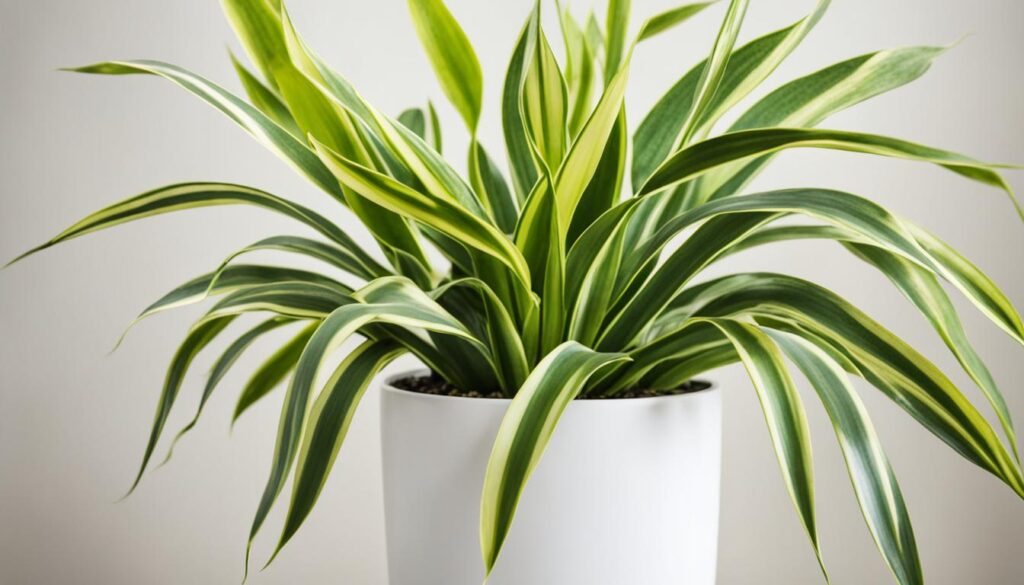
Because it cleans the air, is safe for pets, and doesn’t take much space:
The Mikado Snake Plant is a top choice for those living in apartments. It’s perfect for better air, keeping pets safe, or making your place prettier.
How to Grow a Mikado Snake Plant – Learn to Grow this Indoor Beauty
Growing a Mikado Snake Plant indoors is fun. With care, you can make this plant shine in your home. I’ll show you how to grow and care for a Mikado Snake Plant. This will keep it healthy and beautiful.
Choosing the Right Pot and Soil
Choose a pot with drainage holes for your plant. This stops too much water from building up. For soil, pick a mix that drains well. Use peat moss, perlite, and vermiculite in equal parts. This is perfect for your plant.
Providing Adequate Light
Mikado Snake Plants like bright, indirect light. Put them near a window but not in direct sun. Too much sun can hurt the leaves. If you don’t have enough light, artificial lights can help too.
Watering and Humidity
These plants don’t like too much water. Water when the top soil is dry. Make sure extra water can drain out. They don’t like wet feet. They’re fine with normal indoor humidity too.
Nutrition and Fertilization
During spring and summer, feed your plant monthly. Use half-strength liquid fertilizer. When it’s colder and the plant isn’t growing much, feed it less or not at all.
Pruning and Maintenance
You don’t need to trim these plants much. Just take off any yellow leaves. Clean the leaves with a damp cloth to keep them looking nice. Check for pests or sickness and deal with them fast.
Propagation
You can make more Mikado Snake Plants easily. You can split the plant or use leaf cuttings. If using cuttings, make sure each piece has a node. Put them in moist soil until they grow.
Monitoring for Pests and Diseases
Watch out for bugs like spider mites or mealybugs. You can clean them off or use a safe soap. Also look for diseases like root rot. If you find any, treat them quickly.
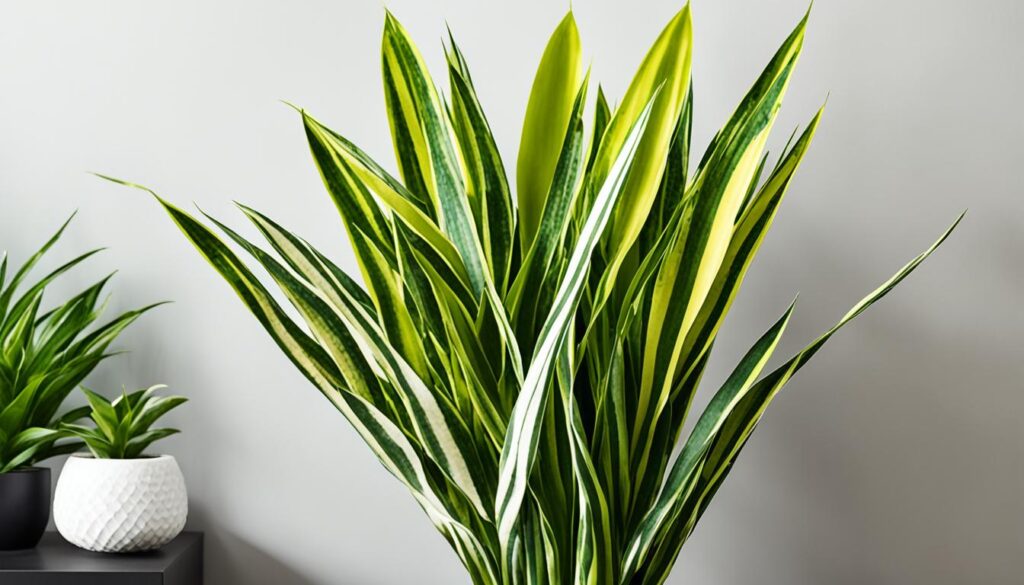
| Aspect of Care | Recommended Techniques |
|---|---|
| Choosing the Right Pot and Soil | Use a pot with drainage holes and a well-draining potting mix. |
| Providing Adequate Light | Place the plant in bright, indirect light. |
| Watering and Humidity | Water when the top inch of soil is dry and maintain average indoor humidity levels. |
| Nutrition and Fertilization | Fertilize monthly with a balanced liquid fertilizer diluted to half strength. |
| Pruning and Maintenance | Remove yellow or dying leaves, wipe leaves regularly, and address pests or diseases promptly. |
| Propagation | Propagate through division or leaf cuttings. |
| Monitoring for Pests and Diseases | Regularly inspect the plant for pests and diseases and take appropriate action as needed. |
Appearance of Mikado Snake Plant
The Mikado Snake Plant is a striking plant for indoors. It makes any room look elegant. Its leaves are dark green with bright, light green stripes that look like tiger prints.
Its leaves have a special pattern. This makes the plant very eye-catching. The stripes on it are bold and fun. They make the plant stand out in any room.
Its leaves stand tall, around 12 to 16 inches high. This adds a nice vertical look. Because it’s not too big, it’s great for small places like apartments.
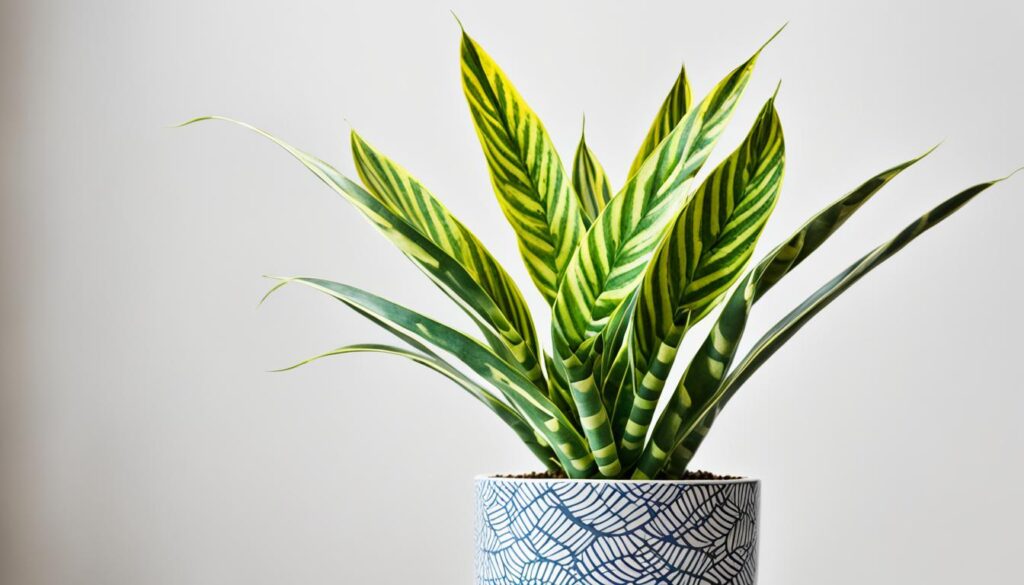
Light Requirements for Mikado Snake Plant
Light is very important for this plant to grow well. Knowing how much light it needs keeps it healthy.
The plant does well in light that is not too bright or direct. It can handle some shade but looks best with the right light. A window facing north or east is the best spot for it. This avoids too much sun that harms the leaves.
If you don’t have enough sunlight, artificial lights can help. Fluorescent or LED lights work well for the Mikado Snake Plant. These lights help it make food and grow strong.
Make sure to place the plant not too close to the light. A distance of 12-24 inches is good, depending on how bright the light is.
The following table shows what kind of light is best:
| Lighting Conditions | Plant Response |
|---|---|
| Moderate to bright, indirect light | Optimal growth and vibrant foliage |
| Low light | Tolerated, but slower growth and less pronounced variegation |
| Direct sunlight | Risk of leaf damage and scorching |
For the plant to do its best, give it the right light. Watching how it reacts to the light and changing things helps it stay beautiful.
Note: The image below showcases a healthy Mikado Snake Plant which exemplifies its unique foliage and green tiger-print striping.
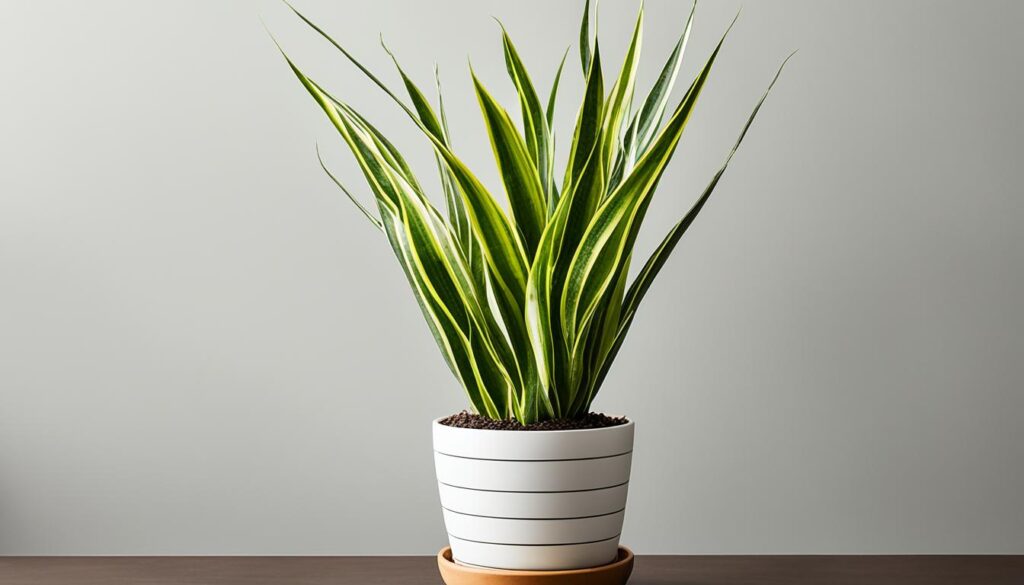
Watering Requirements of The Mikado Snake Plant
Watering the Mikado Snake Plant right is key for it to grow well. You need to know how much water it needs and the right way to water it.
Signs of Overwatering vs. Underwatering
Knowing the signs of too much or too little water is important. This keeps your plant healthy. Here are some things to look for:
- Overwatering: Too much water makes roots rot and causes other issues. Look for leaves turning yellow or droopy, stems that are mushy, and bad smells from the soil.
- Underwatering: Not enough water makes the plant stressed and dry. Leaves may droop or curl, stems become dry, and the soil may shrink away from the pot.
Watch for these signs to know how much to water your Mikado Snake Plant. Then, you can fix your watering schedule as needed.
| Signs | Overwatered Plant | Underwatered Plant |
|---|---|---|
| Leaf Condition | Yellowing or wilting Soft or mushy leaves | Drooping or curling Dry and brittle leaves |
| Stem Condition | Soft or mushy Pungent odor from soil | Dry and firm Soil pulling away from pot edges |
| Soil Moisture | Consistently wet or saturated soil | Dry or compacted soil |
Fertilizing Mikado Snake Plants
Fertilizing Mikado Snake Plants helps them grow well and look great. This section will show why it’s important and how to do it right. I’ll recommend the best fertilizers and tell you how to use them. Fertilizing Mikado Snake Plants not only promotes healthy growth but also enhances their distinctive appearance. It’s crucial to choose the right fertilizer to avoid over or under-fertilizing, which can harm your plant. For optimal results, incorporate kentrell plant care essentials into your routine, ensuring that your Mikado thrives in its environment while displaying vibrant foliage.
Recommended Fertilizer for Mikado Snake Plants
Choosing the right fertilizer is key. It should have nitrogen, phosphorus, and potassium. A 10-10-10 or 20-20-20 NPK ratio is good.
Use a water-soluble fertilizer. It’s easy for the plant to absorb. Make sure it’s made for indoor plants.
Mix the fertilizer with water as the label says. Then, water your plant evenly. Don’t use too much to avoid root damage.
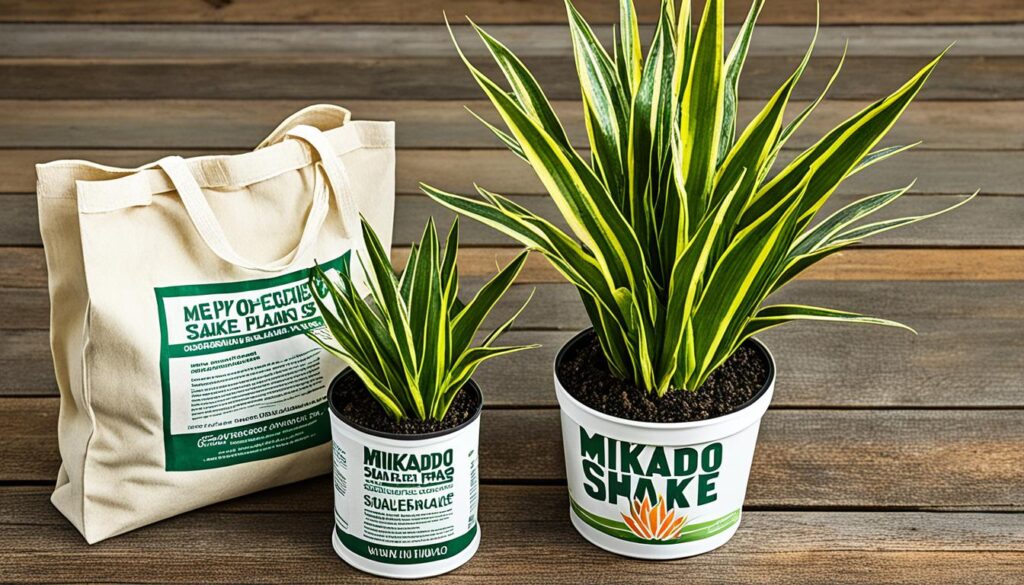
Fertilize from spring to early fall. That’s when your plant grows the most. Don’t fertilize much in winter.
Always check the fertilizer’s instructions. Adjust how often and how much you use. Proper care makes your Mikado Snake Plant beautiful.
Potting Mikado Snake Plants
Proper potting helps Mikado Snake Plants grow well. I’ll show you how to pot your plant. This includes picking the right pot size, the best potting mix, and repotting times.
Choosing the Right Pot Size
Choosing the right pot size is key. It must give roots room to grow. If the pot is too small, roots get cramped. This stops the plant from growing. A big pot can hold too much water. This can cause root rot.
Pick a pot 1-2 inches bigger than the current one. It gives the plant space but won’t overwhelm it. Make sure the pot has holes to drain water. This stops water from sitting at the bottom.
Using the Right Potting Mix for Mikado Snake Plants
The potting mix matters a lot too. It should drain well but keep roots moist. A mix of peat moss, perlite, and coarse sand works well. It lets water flow, stopping roots from soaking.
Or, use a commercial mix for succulents or cacti. These mixes have the right balance for plants like Mikado Snake Plant.
Repotting When Necessary
Mikado Snake Plants need new pots every 2-3 years. You’ll know it’s time if roots peek out of holes. Or if the plant seems too big for its pot.
Take the plant out gently and check the roots. If they’re tight, loosen them. Put the plant in a new pot with fresh mix. Make sure roots spread out. Then, fill in gaps with more mix and water well.
Do this in spring or early summer. That’s the best time for the plant.
Follow these steps to make your Mikado Snake Plant happy. Pick the right pot and potting mix. Repot when needed. Your plant will grow strong and healthy.
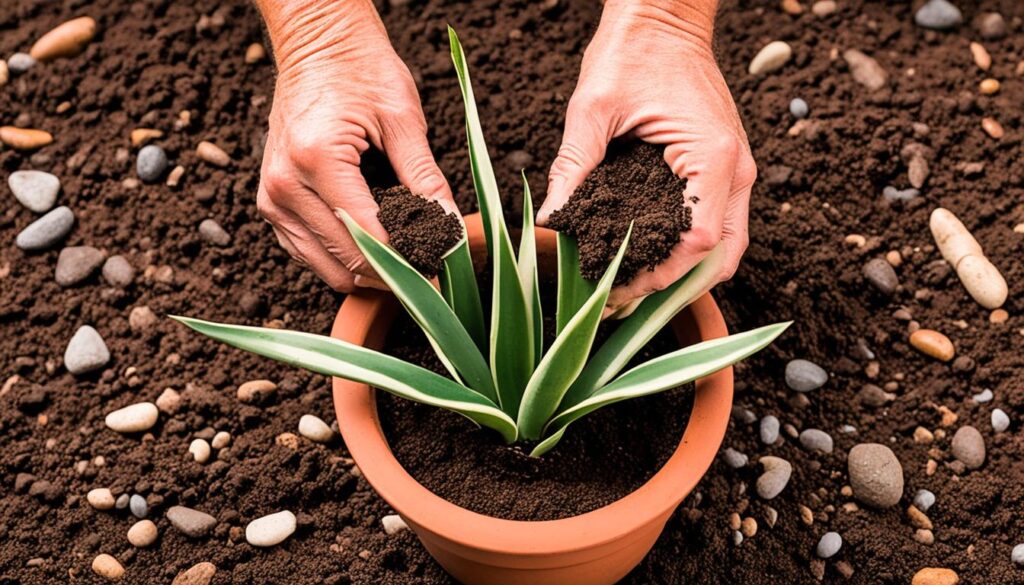
Propagating Mikado Snake Plants
Expanding your Mikado Snake Plant collection is fun. You can share their beauty with friends. There are many ways to do this. You can use stem cuttings or seeds. Each way has its own good parts and things to think about. This lets you pick what’s best for you.
Stem Cuttings Or Seeds?
Stem cuttings are a popular way to get new plants. You cut a healthy piece from the big plant. Then, let it grow roots and turn into a new plant. This way is good because the new plant will be just like the big one.
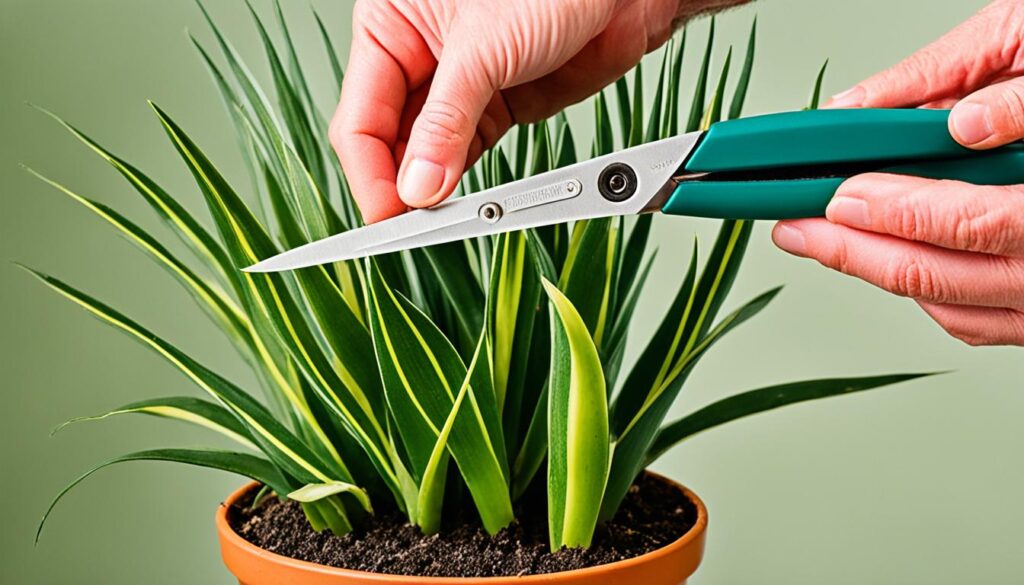
Another way to make new plants is from seeds. This takes more time and work than cuttings. You need to make sure the seeds start growing right. But, it’s very rewarding. You get to see the plant grow from the very start.
Division Of A Mikado Snake Plant
You can also make new plants by dividing them. This means you take a big plant and split it into smaller ones. Each new plant has its own roots. You usually do this when the plant gets too big for its pot. Or when you want more plants.
It’s important to give new plants what they need to grow well. They need the right light, water, and soil. If you take good care of them, you’ll see your new plants grow big and healthy. Growing plants like this can be very satisfying.
Growth and Development of Mikado Snake Plants
I love watching my Mikado Snake Plants grow. They are unique and beautiful. They attract anyone who loves indoor gardening. In this section, let’s look at how Mikado Snake Plants grow. We’ll talk about their growth rate and how tall they get.
Mikado Snake Plants grow slowly but surely. They aren’t fast growers like some plants. This makes them great for small homes. Being patient is important with these plants.
With the right care, these plants can grow 2-3 feet tall. Their size is perfect for small spaces, like apartments and offices. They grow up straight, adding beauty to any room without taking up much space.
As they grow, Mikado Snake Plants show off their beautiful leaves. Their leaves are dark green with cool light green stripes. This pattern stays as they get older. It makes them look special.
To keep your Mikado Snake Plant healthy, remember a few tips. Give them enough light first. They do okay in low light but love bright, indirect light best. Try to put them near a window with filtered sun.
Next, water your plant right. Too much water can hurt it, but not enough can dry it out. Water the plant when the soil’s top inch is dry. It’s better to give them less water than too much.
Last, feed them during their growing months. Use a general houseplant fertilizer that is not too strong. Fertilize in spring and summer as the directions say.
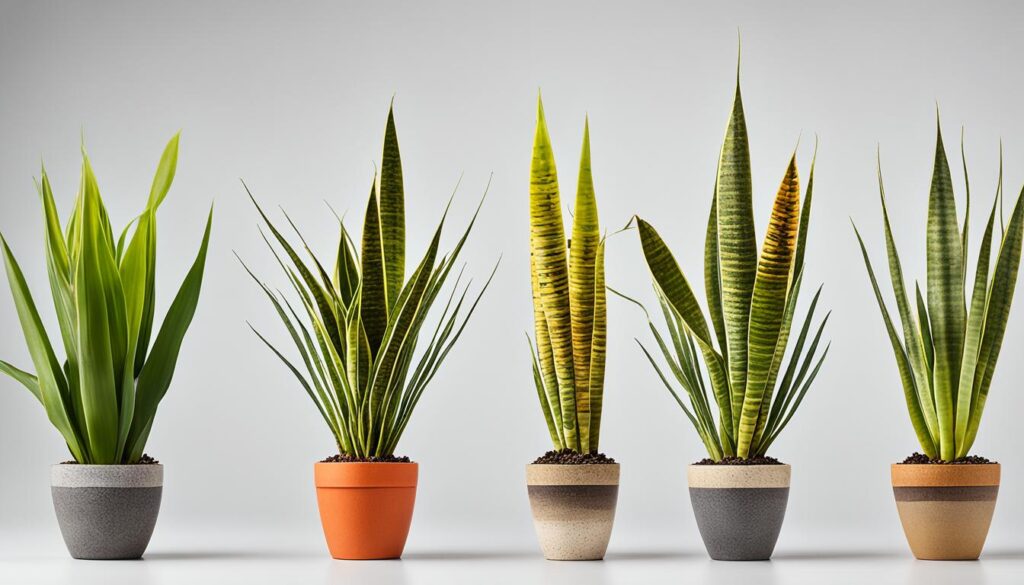
Follow these care tips to help your Mikado Snake Plants grow well. Watching them grow up is really rewarding. They will make any indoor area look beautiful.
Dealing with Pests and Diseases in Mikado Snake Plants
Keeping your Mikado Snake Plant healthy is important. You must watch for pests and diseases. Early action will protect your plant and keep it healthy for a long time.
Spider mites are a common pest for these plants. They eat the plant’s sap and cause damage. Wipe the leaves with a damp cloth to control them. Regularly mist your plant to keep mites away.
Mealybugs can also be a problem. They look like small cottony bugs. If you see mealybugs, tap them with a cotton swab soaked in rubbing alcohol. This will stop them from spreading.
To keep your plant healthy, check it often for pests or diseases. Keep new plants away from others until you’re sure they’re safe. Also, don’t water your plant too much. Too much water can cause fungal issues.
Good care and watching your plant closely are key. Remove any dead leaves to avoid disease. Follow a good watering routine to prevent root problems.
It’s better to prevent issues with your plant than to fix them. Give your plant the right conditions and care. This way, you will have a thriving Mikado Snake Plant.
“Regular inspections and timely action are crucial in ensuring the health and well-being of your Mikado Snake Plant. By promptly addressing pest and disease issues, you can protect your plant and maintain its beauty for years to come.”
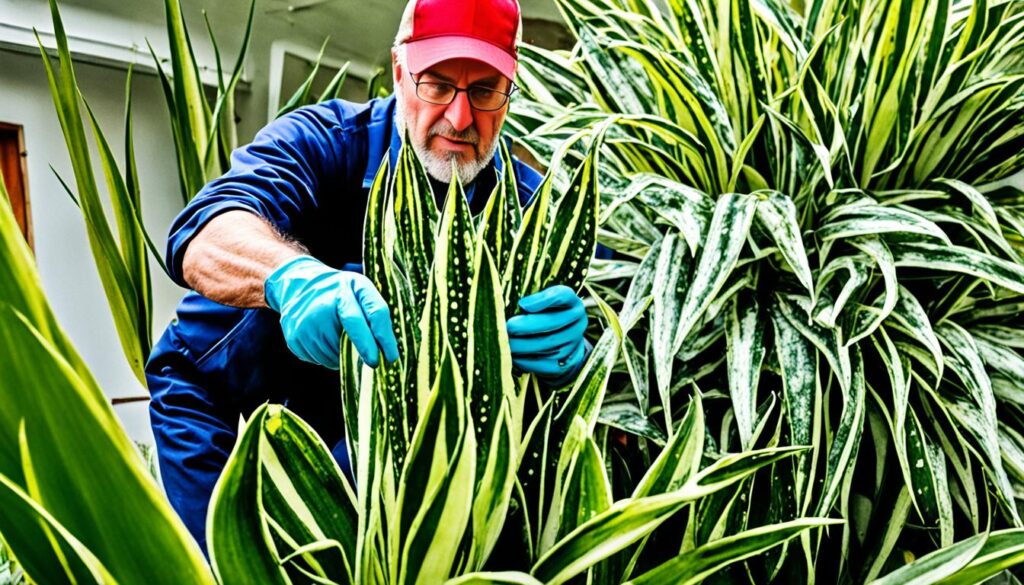
Common Mikado Snake Plant Pests
Owners of Mikado Snake Plants sometimes face bug problems. It’s key to know about these bugs to keep the plants safe.
Spider mites and mealybugs are big troubles for these plants. They can hurt the plant a lot if not stopped.
Spider mites are super tiny bugs. They make webs on plant leaves. They eat the plant’s sap. This makes the plant grow poorly, leaves turn yellow, and white dots show up.
Image of a spider mite-infested Mikado Snake Plant:
Mealybugs are small bugs with a soft body. They look like they have white cotton on them. You find them under leaves. They eat the plant’s sap too. This makes leaves twist, turn yellow, and sticky stuff appears.
Image of a Mikado Snake Plant infested with mealybugs:
To stop these bugs, you must check the plant often. If a plant has bugs, keep it away from others. There are ways to fight the bugs with or without chemicals.
Looking after your plant well, watching it closely, and acting fast will keep it safe from bugs.
Natural Predators
Ladybugs, lacewings, and predatory mites eat pests like spider mites and mealybugs. They help keep Mikado Snake Plants safe.
Add these helpful bugs to your indoor garden to balance it and fight pests naturally. You can buy them or draw them in with special plants.
Isolate Infected Plants
Is your Mikado Snake Plant sick with pests? Isolate it quickly. This stops pests from spreading to other plants.
Move the sick plant away from healthy ones. Check other plants closely for pests, too. Take steps to watch over your plants and fight pests naturally.
Chemical Treatment
Sometimes, natural methods are not enough. Then, you might need to use chemicals.
Pick a safe chemical for indoor plants and use it right. Wear safety gear and follow the rules. Keep people and pets safe.
Before using chemicals, talk to an expert. They can offer help and make sure you use chemicals safely.
Disease Prevention For Mikado Snake Plants
It’s important to keep your Mikado Snake Plants healthy. Follow some easy guidelines to avoid diseases. By doing so, your plants will grow well.
- Sanitation: Keep things clean around your plants. Take away dead or yellow leaves to stop diseases. Always use clean tools and pots to keep plants healthy.
- Avoid Overwatering: Too much water can cause root rot and attract diseases. Let the soil dry a bit before watering again. Make sure water can drain well.
- Provide Optimal Growing Conditions: Healthy Mikado Snake Plants can fight off diseases better. Give your plants enough light and keep humidity right. This helps them stay strong against infections.
- Monitor for Common Diseases: Learn about diseases like root rot and leaf spot. Check your plants often for any unusual signs. Catching diseases early makes treatment easier.
- Practice Integrated Pest Management: Pests can make plants weak and sick. Use a good pest control plan. This includes checking plants, keeping them clean, and using safe pest control.
Use these tips to keep your Mikado Snake Plants healthy. Always pay attention and take good care of them. This will help your indoor garden succeed.
Tips for Maintaining Mikado Snake Plants
Keeping Mikado Snake Plants healthy is key. Here are easy tips to make them flourish.
Wiping Leaves
Wipe your plant’s leaves often. This keeps them free from dust and dirt.
It helps the plant soak up sunlight better. Use a wet cloth for cleaning. This also makes the plant look good and grow well.
Outdoor Exposure
Sometimes, let your plants go outside. Put them in a shade when the weather is nice.
This outdoor time gives them fresh air and light. But keep them out of direct sun to avoid leaf burn.
Adjusting Watering Schedule
Change how often you water with the seasons. Plants need more water when it’s hot and less when it’s cold.
Check the soil to know when to water. Too much water causes root problems. Not enough makes leaves droop.
These tips can help your Mikado Snake Plants stay healthy indoors.
Tips for Successful Overwintering of Mikado Snake Plant
Making sure your Mikado Snake Plant gets through the winter is key. In cold places, it helps them stay alive and well. Here are the best tips for winter care:
- Adjusting Temperature: When it gets cold, move your plant away from chilly winds. Make sure it stays in a warm spot, above 50°F (10°C).
- Maintaining Proper Humidity: Heating your home can make the air too dry for the plant. A humidifier or water tray close to the plant keeps the air moist.
- Providing Indirect Light: Less sun in the winter means your plant needs bright, soft light. A spot near a south or west window works well.
- Reducing Watering: The plant grows slower in cold months, so it needs less water. Let the soil dry a bit before watering again. But don’t let it get too dry. Too much water can harm the roots.
These tips create a good winter home for your Mikado Snake Plant. Watch your plant and change things up as needed for its best care.
Right care makes your plant strong and healthy.
Growing Mikado Snake Plant from Seed
If you want to grow Mikado Snake Plants, starting from seed is fun. You will need patience. But it’s great to see them grow from the beginning. Here are steps to grow them from seeds:
- Seed Preparation: Pick good Mikado Snake Plant seeds. Check that they’re fresh. You can buy seeds from nurseries or online.
- Planting Seeds: Use small trays or pots with good soil. Make little holes and put one seed in each. Cover them lightly with soil.
- Ideal Growing Conditions: These seeds need warm, humid air to start growing. Keep them between 75-85°F (24-29°C). A heat mat helps, or just a warm spot.
- Watering: Soil should be moist, not too wet. Too much water can harm them. Use a spray bottle or a gentle can to water them.
- Germination Time: Seeds usually sprout in 2-4 weeks. It can vary, so don’t rush. Keep the conditions right.
- Seedling Care: When you see the seedlings, they need light but not direct sun. Keep the air between 65-75°F (18-24°C). Soil must stay moist.
- Transplanting: When they’re big enough, move each plant to its own pot. Be careful not to hurt the roots.
- Continued Care: Keep them in bright light but away from direct sunlight. Let the soil dry a bit before watering again. They like warmth and humidity.
- Maturity: It takes a few years for them to fully grow. Change your care as they get bigger. They need light, water, and food to thrive.
Growing Mikado Snake Plants from seeds is cool and rewarding. You get to see them grow up. With care and time, you can grow beautiful Mikado Snake Plants from seeds. They’ll make your home garden special.
Varieties of Mikado Snake Plant
Mikado Snake Plants come in many types. Every type has its own special look. This means you can pick the best one for your home garden. Let’s check out some kinds.
The Mikado Fernwood Mikado is a favorite. It has tall, thin leaves with light green stripes. These stripes stand out against the dark green leaves. It looks elegant anywhere and is very popular.
Then there’s the Mikado Hahnii. It’s great for small places or to put on a table. It has a round shape and green leaves. It makes any room feel peaceful and beautiful.
Looking for something bright? Try the Mikado Trifasciata Laurentii. It has dark green leaves with bright yellow edges. This makes it really stand out in a room. It’s perfect to add a pop of color.
FAQ
Q: Is the Mikado Snake Plant air-purifying?
A: Yes, it cleans the air. It takes out toxins, good for small, stuffy places.
Q: Is the Mikado Snake Plant pet-friendly?
A: Yes, it’s safe for cats and dogs. Pet owners can feel happy adding this plant.
Q: How big does the Mikado Snake Plant get?
A: Indoors, it grows 2 to 3 feet tall. It’s perfect for tight spaces.
Q: What pot and soil should I choose for growing a Mikado Snake Plant?
A: Use a pot that drains water well. Mix potting soil, perlite, and sand for the best soil.
Q: How much light does the Mikado Snake Plant need?
A: It likes moderate to bright light but can handle low light. For strong growth, give it sunlight or artificial light.
Q: How often should I water my Mikado Snake Plant?
A: Water it when the top inch of soil is dry. Be careful not to water it too much.
Q: What type of fertilizer should I use for my Mikado Snake Plant?
A: Use a balanced fertilizer, diluted as the package says. Apply it once a month in spring and summer.
Q: How do I pot a Mikado Snake Plant correctly?
A: Pick a slightly bigger pot with holes at the bottom. Put the plant in with well-draining soil. Water it well afterwards.
Q: How do I propagate a Mikado Snake Plant?
A: You can use stem cuttings or divide the plant. For cuttings, plant them in well-draining soil. For division, separate and replant.
Q: What are the common pests and diseases that can affect Mikado Snake Plants?
A: Watch out for spider mites and mealybugs. Root rot and leaf spot can also happen. Check your plant and treat if needed.
Q: What are the tips for maintaining Mikado Snake Plants?
A: Clean the leaves and adjust watering as the seasons change. Give it the right light and temperature for health.
Q: How do I overwinter a Mikado Snake Plant?
A: Keep it cooler and water less in winter. Avoid cold places. Give it indirect light and keep humidity moderate.
Q: How do I grow a Mikado Snake Plant from seed?
A: Starting from seed takes time. Provide warmth, humidity, and care from germination to seedling.
Q: What are the different varieties of Mikado Snake Plant?
A: There are many types, each with unique leaves. Popular ones include Sansevieria ‘Mikado,’ ‘Superba,’ and ‘Moonshine.’

